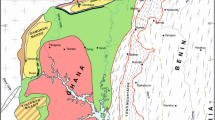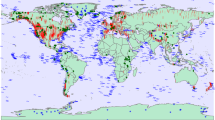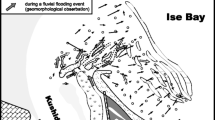Abstract
Data from point counts of 376 thin sections from six stratigraphic sections in the Chickamauga Group carbonates (Middle Ordovician of northeastern Alabama) were smoothed by time-trend methods. The resulting curves were plotted against the stratigraphic sections to show depositional trends and to facilitate interpretation of depositional environments. The depositional environments in the lower third of the sequence studied were dominantly subtidal; in the middle portions they were interbedded subtidal, intertidal, and supratidal; in the lower upper third they were supratidal; and in the uppermost portions they were interbedded subtidal, intertidal, and supratidal. Time-trend methods proved to be useful in this study, for they are easy to use and eliminate much noise observed in the data, whereas preserving major trends. Correlation between outcrops was by means of two continuous bentonites; comparison of the time-trend curves show that they would have been useful for correlation if the bentonites had been absent, although small differences in the vertical positions of beds between localities (indicating lateral migration of environments) would not have been detected by time-trend methods.
Similar content being viewed by others
References
Fox, W. T., 1964,Fortran andFad program for calculating and plotting time-trend curves using an IBM 7090 or 7094/1400 computer system: Kansas Geol. Survey Sp. Dist. Publ. 12, 24 p.
Fox, W. T., and Brown, J. A., 1965, The use of time-trend analysis for environmental interpretation of limestone: Jour. Geology, v. 73, no. 3, p. 510–518.
Harbaugh, J. W., and Merriam, D. F., 1968, Computer application in stratigraphic analysis: John Wiley & Sons, New York, 282 p.
Laporte, L. F., 1967, Carbonate deposition near sea level and resulting facies mosaic: Manlius Formation (Lower Devonian) of New York State: Am. Assoc. Petroleum Geologists Bull., v. 52, no. 1, p. 73–101.
McKinney, F. K., 1970, Trepostomatous ectoprocts of Lower Chickamauga Group, Wills Valley, Alabama: Unpubl. doctoral dissertation, Univ. North Carolina, 263 p.
Shinn, E. A., Lloyd, R. M., and Ginsburg, R.N., 1969, Anatomy of a modern carbonate tidal flat, Andros Island, Bahamas: Jour. Sed. Pet., v. 37, no. 3, p. 633–648.
Textoris, D. A., 1968, Petrology of supratidal, intertidal, and shallow subtidal carbonates, Black River Group, Middle Ordovician, New York, U.S.A.: Proc. 23rd Intern. Geol. Congress, v. 8, p. 227–248.
Vistelius, A. B., 1967, Studies in mathematical geology: Consultants Bureau, New York, 294 p.
Wilson, A. O., 1970, Petrogenesis of parts of Black River Age strata of the Chickamauga Limestone, Etowah and Dekalb Counties, Alabama: Unpubl. doctoral dissertation, Univ. North Carolina, 112 p.
Author information
Authors and Affiliations
Rights and permissions
About this article
Cite this article
Wilson, A.O. Use of time-trend curves to interpret depositional environments in portions of the Chickamauga Group carbonates (Middle Ordovician, northeastern Alabama). Mathematical Geology 4, 45–54 (1972). https://doi.org/10.1007/BF02083192
Received:
Issue Date:
DOI: https://doi.org/10.1007/BF02083192




